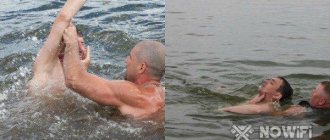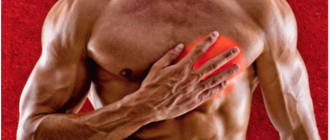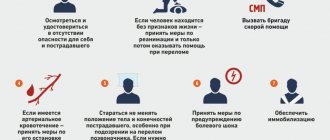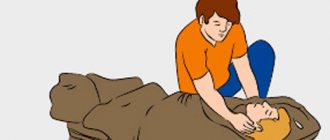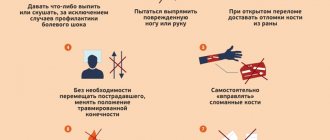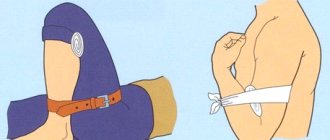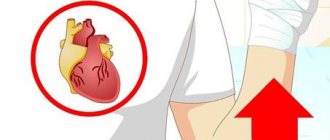Epilepsy attacks are chronic. This psychoneurological disease can be either acquired or hereditary. To date, epilepsy cannot be cured, but scientists continue research. With the efforts of a competent physician, the frequency of seizures can be reduced.
An epileptic seizure begins suddenly. The patient must be provided with timely assistance, otherwise death is possible. Relatives of a patient with epilepsy should know how to help during a seizure. We need to act without delay.
Rules of first aid for an epileptic attack
An attack of epilepsy is not as terrible and dangerous as failure to provide assistance to the patient at this moment.
It is necessary to remove sharp, heavy objects and those that are dangerous for the patient and others. It is advisable to find something soft (pillow, blanket, towel, folded clothes) to place under the patient’s head. Do not hold the patient by force - this will worsen the condition. You need to note for yourself the time the attack began; if it lasts more than 5 minutes, you need to call a medical ambulance. There is no need to unclench your jaws so as not to injure your tongue, teeth and oral mucosa due to muscle hypertonicity.
It is necessary to fix the victim’s head between the legs, place clothes, a blanket, a pillow under it, or roll up the clothes. Tight clothing needs to be loosened. If there is excessive salivation, then the head must be turned to the side. The patient may experience spontaneous urination.
What should you not do during an attack?
There is no need to restrain a person by force, try to bring him to his senses, hit him in the face, or bother him.
This will lead to greater trauma for the patient. If your teeth are clenched, there is no need to force your jaw open. Muscles are hypertonic and such actions can injure teeth, tongue and block the airways with tooth fragments. You cannot move or transfer a person to another place; such measures are necessary if the attack began in a place that threatens life. Immediately after its completion, there is no need to give the victim water or medications, because muscle function has not yet been restored and the patient may choke. You can't do chest compressions or artificial ventilation.
Chapter 3.
How to help yourself or a loved one during an attack of seizures or changes in consciousness.
(Also read the separate recommendations - the chapter “ADMINISTRATION OF ANTI-CONVVANT DRUGS at home to interrupt or prevent frequently recurring seizures”)
In most cases, I am able to prevent the patient from having a recurrence of attacks. However, at the beginning of treatment, as well as in the event of a possible relapse after stopping medication, attacks may recur. In addition, according to scientists from European and American centers for the treatment of epilepsy, 20% of patients cannot completely relieve seizures (for such cases in the West there is a special term - “uncontrolled epilepsy”). Therefore, the patient himself, as well as relatives of a child or sick adult, need to know what to do during an attack. To navigate the peculiarities of the course of attacks, it is also advisable for you to familiarize yourself with the recommendations: “WHAT TYPES OF ATTACKS ARE. HOW THEY DEVELOP AND PROCEED.”
HOW TO HELP BEFORE AN ATTACK
Occasionally, before an attack, a change in a person’s behavior is noted; somewhat more often, he may only have an internal feeling of an approaching attack (aura). For each patient, these pre-attack phenomena are usually unchanged from attack to attack.
It is necessary to teach a person to pay attention to the warning signs and aura of attacks, first of all, so that he has time to find a safe place. If the attacks are accompanied by falls or convulsions, the patient should lie down before the attack begins, and if possible, on something soft.
An adult and a child, if he is old enough, should be asked about these special sensations (aura) emanating from the epi-focus just before the attack, and for one more reason. The fact is that some people manage to prevent an attack when an aura appears. The following conditions are necessary to use these methods of natural attack prevention:
1. Preserved intelligence in an adult or a fairly old age in a child
2. Presence of warning signs or aura before attacks
3. Presence of provoking factors before an attack
Natural ways to interrupt an incipient attack most often involve diverting attention from the area of the body in which the attack begins.
The easiest way to do this is by causing pain or other intense sensation in any part of the body in order to “interrupt” the sensation of the aura with a stronger stimulus: some people wear an elastic bandage on their arm (wrist) and, at the moment when they feel an attack approaching, they twist it sharply to feel the pain. The same effect is achieved when a person begins to quickly twirl a ring on his finger or an earring in his earlobe and pinch himself strongly. Another patient found that he achieved the same result by vigorously and frequently tapping his hand on some hard object. Self-stimulation by brisk walking, forceful pinching, or a sudden shift of attention while you are either in a seizure-provoking situation or just about to have a seizure are often very effective ways to prevent seizures.
For some, an excellent way to distract attention and, accordingly, suppress a seizure is, for example, loud sneezing.
In other cases, it is better to act on that part of the body or mental function that is “participating” in the attack. If a convulsive seizure begins with the same involuntary movement of a limb (say, flexion of the hand), then this seizure can be suppressed by a movement opposite to the original one (in the case of the hand, it is possible to simply straighten it). Simply trying to keep that limb still can also suppress the occurrence of an epileptic seizure. If the attack begins with tingling in the arm or other limb, then the patient may try to interrupt the attack by tightly squeezing that limb with the other hand, twisting it from side to side. If an attack begins with the sensation of an unusual odor, you can interrupt it by inhaling the even stronger smell of ammonia.
Some patients find more complex psychological distraction techniques to suppress the area of excitation in the brain - they change the pace and patterns of thinking, their motor or mental activity.
Other ways to suppress an incipient attack is to counteract the emotion that causes the attack: if you have attacks in a state of sadness or boredom, then you can choose the method of self-excitation as a counteraction. One of the patients who had complex partial seizures noticed that he was able to stop the further development of the seizure simply by loudly saying the word “No!” out loud, or by abruptly switching his attention to another object. In many patients, especially those who suffer from complex partial seizures, they occur against a background of anxiety or feelings of sadness. Measures to counteract a seizure in this case will consist of trying to avoid any thoughts that make you sad and melancholy, or a sharp and complete switch of attention.
HOW TO HELP DURING AN ATTACK
There are no real ways for others to interrupt an attack that has already begun at home - it usually ends on its own when the epi-discharge in the brain is depleted. Your personal assistance during an unexpected attack is necessary mainly to protect the patient from injury during an attack and consists of the following:
1. During an ongoing attack, do not move the patient to another place, except when he is near sharp or hot objects, electrical equipment, or on a roadway with heavy traffic.
2. In case of general convulsions, it is necessary to place the patient’s head on something soft, for example, on rolled up clothes, or put your hand under the back of the head so that it does not hit the hard floor or ground. However, in no case should you forcibly hold your head or other parts of the body motionless, trying to forcefully overcome the cramps. This will not stop the convulsions, but the patient may get injured from this.
3. To make breathing easier, loosen the patient’s tight parts of clothing: belt, belts, bra, tie, and unbutton the collar. If the patient is lying face down, turn him on his side or back so that the breathing holes are free for air to enter. For the same purpose, remove the pillow and excess linen (blanket) from the bed.
4. DO NOT give any drink to a patient during an attack or when consciousness is impaired due to the possibility of choking.
5. If the patient has visible saliva on his lips, there is a possibility that the saliva will enter the respiratory tract and the patient will cough. Therefore, if convulsions allow it, turn the patient’s head to the side, and, if possible, a little down so that saliva does not flow into the respiratory tract. During an attack, and more often after it, there may be vomiting; in a supine position, vomit can enter the respiratory tract. Therefore, it is better to turn not only the head, but also the entire body of the patient on its side. At the same time, scaffold your body with pillows or folded clothes so that the posture is stable. Make sure that the patient does not turn face down on his stomach and suffocate. If cramps prevent the patient from turning - and under no circumstances use force to counteract the cramps when trying to change position, wait until the cramps stop. Even after this, you can not rush to turn him over, but carefully monitor the patient and quickly turn him over at the first sign of the urge to vomit.
6. During an attack, it is possible to bite the tongue or cheek with teeth clenched during tonic convulsions. You may have seen the American film “Cleopatra” with the famous actress Elizabeth Taylor in the title role: Julius Caesar, who suffered from epilepsy, when an attack was approaching, bit his teeth on a special block of soft wood to prevent biting his tongue and crumbling his teeth. Do not rush to make such a block; treatment usually allows you to remove or significantly reduce these attacks.
To prevent tongue bite, some experts recommend placing the handle of a spoon wrapped in a piece of cloth (scarf) between the patient’s teeth and holding it with your hand. There is no need to do this - the patient may break his teeth on the spoon or suffocate due to the unwound fabric.
Most often, an attack develops quickly - and if a person has already clenched his teeth, there is no point in putting anything in his mouth. In addition, practice has shown that attempting the above prevention of tongue biting can cause dental injuries and other troubles. Therefore, do not put anything in the patient’s mouth. Discuss the advisability of using this method with your doctor if tongue biting recurs during repeated attacks.
HOW TO HELP AFTER AN ATTACK
Your help after the attack is over is as follows:
1. Take the person to a comfortable place or help him get there if he wants to sleep after the attack ends. When he falls asleep, you don’t need to wake him up until he wakes up. If a person does not come to his senses after an attack and immediately “falls asleep”, and the sleep is suspiciously deep and is accompanied by periodic twitching, you can “stimulate” the patient a little to make sure whether he reacts to you, or whether he has fallen into a convulsive state and to whom. If the patient does not respond, call an ambulance.
2. After the attack, when the patient has fully regained consciousness, it is recommended to give him a cup of sweet tea. However, there is no need to interrupt the patient’s sleep for this if he falls asleep after an attack. DO NOT give any drink to the patient during an attack or when consciousness is impaired.
Some non-convulsive seizures also require assistance from others, especially states of altered consciousness during which the person may make unconscious movements (psychomotor seizures). At the same time, he can get injured by bumping into something, going to the edge and falling from a height, manipulating a sharp object. During such an attack, gently change the direction of the patient’s movement away from the dangerous object, take away dangerous objects from him, talk calmly with the patient so that he is not afraid of the unusual situation when he comes to his senses.
WHAT NOT TO DO DURING AN ATTACK
Using traditional medicine methods is pointless and sometimes harmful, including covering the patient with something, burning some objects, causing any irritation, including reflexology and acupuncture (irritation of certain points on the body). Do not try to do artificial respiration or indirect cardiac massage during convulsions - this is pointless - you will not be able to breathe air into your lungs, since the cramps of the respiratory muscles will not allow you to do this. After the cessation of convulsions, breathing almost always recovers on its own.
Do not put anything in a person's mouth during an attack.
IS THERE A THREAT TO LIFE DURING AN ATTACK?
With proper treatment and following the recommendations, there is no danger to life.
Some attacks are accompanied by pronounced tonic convulsions, which consist of tensing the muscles of the body, contracting the limbs, and freezing in a certain position. Tonic convulsions can also seize the respiratory muscles, making breathing impossible. Usually the period of tonic convulsions is short-lived. If it drags on, then a sign of oxygen starvation is a bluish tint of the skin and lips. Slight blueness of the lips and nasolabial triangle often occurs during a normal attack and is therefore not dangerous.
A sign of danger is a more pronounced bluishness that spreads to the entire face and other parts of the body. Such severe attacks can occur due to inadequate treatment or status epilepticus. Status epilepticus is a condition in which an attack lasts more than 15 minutes or attacks follow one another, but the patient does not regain consciousness in the intervals between attacks.
During convulsions, despite the cessation of breathing and possible bluishness of the face, it is pointless to give the patient oxygen or perform artificial respiration. In this case, the air will still not get into the respiratory tract and lungs due to the stiffness of the respiratory muscles. Usually, immediately after the cessation of tonic tension of the body, the patient begins to breathe and the cyanosis gradually disappears (this can occur against the background of ongoing twitching and disturbances of consciousness). There is a very small possibility that breathing after a long stop in the case of severe convulsions is not restored (tonic tension decreases and the body begins to “go limp”, but there is no breathing and the cyanosis does not disappear, but on the contrary intensifies). In this case, it is necessary to immediately begin artificial respiration mouth to mouth until spontaneous breathing occurs. In all other cases, do not attempt artificial respiration. When starting artificial respiration, you must make sure that there is no vomit in the mouth and throat; if there is any, you must quickly wrap your index finger with a towel and clear the accessible airways of vomit.
Another possible danger is associated with the possibility of vomiting during an attack or immediately after it (when the patient is still unconscious) with vomit getting into the respiratory tract. Therefore, during an attack, do not panic, but wait for the moment when you can turn the person on his side so that he does not suffocate on his vomit.
If the patient is unconscious during an attack or immediately after it, it is necessary to control the position of his body and head - so that he does not suffocate, pressing his face into a pillow or any surface in a position on his stomach, or does not choke in his vomit when lying on his back. This is why tonic nocturnal attacks are most dangerous when there is no one near the person. Therefore, if a child with night attacks has the habit of sleeping on his stomach, we need to wean him off this.
In all my practice, there has not been a case of a patient dying during an attack at home or on the street - the above recommendations are a kind of additional insurance for some rare cases.
An exception to all of the above rules is an attack in the form of laryngospasm during rickets in children of the first year of life (spasmophilia). Laryngospasm is spasm and narrowing of the airway (larynx), which may or may not be accompanied by tonic spasms. With laryngospasm, unlike a normal convulsive attack, there is not one single cessation of breathing at the beginning of tonic tension of the body, but difficulty breathing, sometimes with a sound reminiscent of a rooster's crow. Respiratory cessation during laryngospasm can also occur, but it usually does not occur immediately, but after several noisy breaths. Unlike epileptic seizures, giving compressed oxygen can help with laryngospasm. You can try to interrupt a prolonged attack of laryngeal spasm by irritating the back wall of the pharynx and the root of the tongue. If breathing stops, artificial respiration is performed until the first breath is taken.
IF THE ATTACK HAPPENED IN WATER (for information on preventing accidents in water, read the relevant sections of the recommendations “LIFE STYLE DURING EPIC ATTACKS”)
1. Support the child so that his head is above the surface of the water.
2. After pulling the patient out of the water, make sure he is breathing. If not, place him with his stomach on your bent knee and clean the mucus from his mouth with your fingers. After pouring out the water, quickly place him on his back, tilt his head back so that the airways take the shape of a straight tube, and perform mouth-to-mouth artificial respiration. The chest should expand in time with your breathing.
You must know how to perform artificial respiration correctly and train for this.
3. Even if the rescued person does not complain about anything after being under water, call an ambulance or go to the hospital, as water that gets into the lungs can cause some complications.
WHEN TO CALL AN AMBULANCE
During an attack, you must be near the patient and perform the steps described above. After the end of the attack, you must call an ambulance in the following case: 1/ if the convulsive part of the attack lasted two or more minutes longer than is usually the case for your child or loved one; if the attack lasted more than 5 minutes; 2/ if the attack recurs (two or more attacks within a few hours); 3/ if the patient does not come to his senses after the attack and immediately “falls asleep”, and the sleep is suspiciously deep and is accompanied by periodic twitching, and when vigorous attempts are made to wake him up, he does not answer your simple questions (“Can you hear me”, etc.) and does not fixes his gaze on you; 4 / if after an attack the patient has a confused consciousness - he answers questions poorly and incorrectly, tries to go somewhere, has poor orientation in the time and place where he is; if after an attack the patient looks sick; 5/ if there are noticeable injuries.
In case of repeated attacks or the threat of their recurrence, the emergency doctor prescribes the administration of diazepam or sodium hydroxybutyrate. The introduction of these drugs into a vein can interrupt an attack immediately, but emergency doctors do not administer them into a vein for fear of suppression of the respiratory center by these drugs in case of increased sensitivity to them, their absence or other reasons. The same medicine, injected intramuscularly into the buttock, will begin to have an effect only after 15-20 minutes. Therefore, if attacks are not isolated, but tend to recur several times over 1-2 hours in the form of series, it is advisable to have these drugs at home and a brief extract from the medical history about the dose in which this drug was effectively administered intramuscularly or intravenously. In some In cases, it is clear to the doctor immediately or after the lack of effect from the above administration that the patient requires hospitalization.
To the table of contents of the article “Convulsions, epileptic seizures and epilepsy.”
Manifestations of a grand mal seizure
An attack with loss of consciousness, severe convulsions of the body and limbs is a grand mal seizure.
Its symptoms:
- before this, the patient feels an unusual smell or hears a sound;
- pulse may be normal;
- sudden loss of consciousness, convulsive movements of the body, head, arms and legs;
- the tongue may be bitten, blue in color, pupils do not react to light;
- foam may be released from the mouth;
- respiratory arrest may occur, but quickly recovers;
- duration – from 20 seconds to several minutes.
Memo for the patient
Attack with convulsions
- Protect my head.
- Do not restrain my movements unless I am in danger.
- Don't put anything in my mouth, especially your fingers.
- When the attack is over, talk to me, put me on my side so that I can breathe easier.
- Make sure that I can completely rest and calm down after the attack ends.
- Please note there is usually no need to call the medical staff unless the attack lasts longer than usual for me, or if the seizures occur one after another.
If you have an attack without convulsions
- Do not restrain my movements unless I am in danger.
- Reassure me and stay with me during the state of confusion that may follow an attack.
- Stay with me until I fully regain consciousness and am able to talk to you.
Causes of occurrence and development
The appearance of a convulsive attack can be due to a number of reasons:
- brain tumor, meningitis, stroke;
- alcohol in high doses, drugs;
- poisoning with chemicals, poisons, paints and varnishes;
- diseases of the liver and kidneys that impair the functioning of these organs.
The occurrence of idiopathic epilepsy is associated with heredity, does not cause changes in the psyche, and most often manifests itself before the age of 25. This form of epilepsy is easily corrected with therapy.
How to spot an impending seizure
The seizure usually occurs suddenly. A person who suffers from epilepsy usually cannot accurately predict the time of an attack and the situation in which it will occur. Often, patients with epilepsy experience tension, fear that an attack will happen and that this will cause a negative reaction from others. A number of people note that they observe an aura before the onset of seizures. This may be a state of euphoria, unusual smells, sounds, a sense of taste, or a feeling that such a situation has already happened (déjà vu).
Famous epileptics
People who went down in history were also susceptible to epilepsy. Among them are Julius Caesar, Alexander the Great, Nostradamus, Dante Alighieri, Ivan the Terrible, Napoleon Bonaparte, Alfred Nobel.
For example, epilepsy was one of the diagnoses of the brilliant Ludwig van Beethoven. In addition, epilepsy was a constant companion of Nicolo Paganini and is considered one of the supposed reasons why the great composer avoided people and they were in no hurry to get closer to him.
Vincent Van Gogh suffered from epilepsy and it is believed that the order of society brought him to mental illness for this reason. There is even a version that the artist cut off his ear in a fit, unable to control his hands.
Lewis Carroll, Lord Byron, Fyodor Dostoevsky, Charles Dickens, Pyotr Tchaikovsky - all these famous writers, composers, poets and many other famous people suffered from epilepsy.
Of the living stars, Elton John, actor Hugo Weaving and many others are susceptible to epilepsy.
Treatment
Epilepsy is treated with medication.
The doctor prescribes anticonvulsants; they suppress the occurrence of pathological impulses in the brain. Additionally, psychotropic drugs (hypnotics, antidepressants, tranquilizers) are prescribed. Psychotropic medications should be taken without violating the doses prescribed by the doctor. Because they may be triggers for attacks or side effects. Therapy is not always lifelong. The doctor monitors the patient and if there is noticeable improvement and there are no recurrent attacks, then therapy can be adjusted, even to the point of discontinuation.
Relief of status epilepticus. Drugs
We usually relieve status epilepticus using a number of measures. At the very first stage, we provide the patient with the opportunity to breathe freely. This is followed by oxygen treatment - oxygen therapy.
We administer Diazepam intravenously, not exceeding the daily dose, which is 40 mg. A serious side effect of this medication is insufficient pulmonary ventilation.
Our doctors carry out further treatment of status epilepticus using Depakine, Diazepam, Feniton and other drugs, the choice of which depends on the stage of SE. Like all medications, medications administered to a patient for ES have side effects.
The most common of which are:
- A sharp decrease in potassium in the body;
- Sclerosis of veins;
- Acute toxic hepatitis;
- A sharp decrease in blood pressure, accompanied by dizziness, drowsiness, and often visual disturbances.
If the stage is advanced, then we treat ES using the drugs Phenobarbital, Lorazepam and others.
The measures carried out by our doctors during the refractory stage of epistatus boil down to intubation, artificial ventilation of the lungs, and correction of the water-salt balance of the body.
In case of critical condition of the patient, we provide barbiturate anesthesia. Over 20 seconds, the doctor administers 100 to 250 mg of sodium thiopental as an intravenous injection. The duration of anesthesia can range from 12 hours to a whole day.
We administer Dexamethasone and Mannitol by injection to prevent brain swelling. Our doctors use drugs such as Magnesia and others with similar effects to restore metabolism and proper circulation of cerebrospinal fluid.
